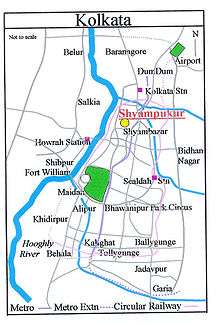Shyampukur
| Shyampukur | |
|---|---|
| Neighbourhood in Kolkata (Calcutta) | |
 | |
| Country |
|
| State | West Bengal |
| City | Kolkata |
| Ward |
|
| Metro Station | Shyambazar, Sovabazar |
| Parliamentary constituency | Kolkata Uttar |
| Assembly constituency | Shyampukur |
| Elevation | 36 ft (11 m) |
| Time zone | IST (UTC+5:30) |
| PIN | 700 006 |
| Area code(s) | +91 33 |
Shyampukur is a neighbourhood in north Kolkata, earlier known as Calcutta, in the Indian state of West Bengal. As a neighbourhood, it covers a small area but its importance is primarily because of the police station and the assembly constituency.
Etymology
Shyampukur, like its neighbour Shyambazar, is likely to have been named in honour of Shyam Rai (or Gobinda), the attendant of the goddess Kali, the household deity of the Basaks, who with the Setts were amongst the first to have settled in Sutanuti, after having cleared the jungles.[1]
History
Shyampukur is in the heart of what was Sutanuti. It was one of police stations mentioned in the earliest list of police stations of Kolkata prepared in 1785. After the Battle of Plassey, in 1757, the British settled down to more organised administration in Kolkata. One of the developments was the police station, which also provided civic facilities. The Police Commissioner doubled as Municipal Chairman till 1888. Shyampukur was one of the twenty-five Police Section Houses in 1888. Shyampukur was overtaken in importance by Shyambazar and Baghbazar, the area being the citadel of Bengali aristocracy.[2]
Geography
Shyampukur police station of Kolkata Police is spread over Shyambazar, Bagabazar and Kumortuli and a part of Shovabazar. Bagbazar ghat, Promoda Sundari ghat, Kashi Mitra ghat, Kumortuli ghat and Shovabazar ghat on the Hooghly River are within the jurisdiction of Shyampukur police station.[3]
Demographics
Shyampukur police station area spread over ward nos. 7 (Baghbazar), 8 (Bagabazar-Shovabazar), 9 (Shovabazar), 10 (part of Shyambazar), and 11 (partly under Shyapukur and partly under Bartola) had a total population of 110,420 in 2001. Out of this 66,359 were males and 54,061 were females. Certain pockets such as ward nos. 8,9, and 11 recorded negative decadal growth.[4]
Early landmarks
In 1891, Mohun Bagan shifted its ground from Phariapukur to Shyampukur as a result of the benevolence of the Maharaja of Shyampukur, Durga Charan Laha. Later, the club's ground was moved to Shyam Square.[5]
When Jamshedji Framji Madan entered the ‘bioscope’ scene in 1902, he began to screen films in tents set up on the Maidan and in Shyampukur.[6]
The barowari Durga Puja organised at Shyampukur in 1911 was the second in Kolkata.[7]
Ramakrishna connection
In 1885, Ramakrishna Paramhansa stayed at 55 Shyampukur Street, known as Shyampukur Bati, for several days after leaving Dakshineswar for treatment of throat cancer. He stayed there before moving to Cossipore Udyanbati. The house has now been converted into a museum displaying articles used by him during his stay there and some paintings. Among other objects on display are parts of the camera with which the first picture of Ramakrishna was taken.[8][9]
References
- ↑ Cotton, H.E.A., Calcutta Old and New, 1909/1980, p. 291, General Printers and Publishers Pvt. Ltd.
- ↑ Nair, P. Thankappan in The Growth and Development of Old Calcutta, in Calcutta, the Living City, Vol. I, edited by Sukanta Chaudhuri, pp. 15-16, Oxford University Press, ISBN 978-0-19-563696-3.
- ↑ "Shyampukur Police Station". Kolkata Police. Archived from the original on 2007-09-27. Retrieved 2007-10-10.
- ↑ "Provisional Population Totals, West Bengal, Table 4". Population, Decadal Growth Rate, Density and General Sex Ratio by Residence and Sex, West Bengal/ District/ Sub District, 1991 and 2001. Census Commission. Retrieved 2007-10-10.
- ↑ "www.the-aiff.com". Mohun Bagan Athletic Club. All India Football Federation. Archived from the original on November 17, 2007. Retrieved 2007-10-10.
- ↑ Banerji, Samik, The Early Years of Calcutta Cinema, in Calcutta, the Living City, Vol II, p. 294, edited by Sukanta Chaudhuri, 1990/2005, Oxford University Press, ISBN 0-19-563697-X.
- ↑ Kolkatar karcha – Sekaler Durga Puja, Ananda Bazaar Patrika, (Bengali), 15 October 2007
- ↑ Dutta, Swapan. "Ramakrishna relics - Museum at Sage Residence". The Telegraph, 23 October 2006. Retrieved 2007-10-10.
- ↑ Mitra, Sramana. "As India Builds". Essay.
External links
![]() Kolkata/North Kolkata travel guide from Wikivoyage
Kolkata/North Kolkata travel guide from Wikivoyage
Coordinates: 22°35′56″N 88°22′08″E / 22.599°N 88.369°E